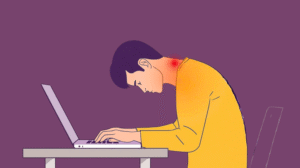In today’s modern lifestyle, prolonged sitting, long hours at computers, and excessive smartphone use have made poor posture a common issue. From office workers to students and drivers, most individuals spend a large portion of their day in positions that place unnecessary strain on the spine and surrounding muscles. Over time, this can lead to chronic pain in the neck, shoulders, and lower back, fatigue, and long-term musculoskeletal issues.
Posture corrector belts are wearable devices designed to support spinal alignment, gently pull the shoulders back, and provide proprioceptive feedback to help train the body to maintain proper posture. These belts serve not only as a corrective tool but also as a preventive measure to protect long-term spinal health.
This article explores the causes and consequences of poor posture, the types and mechanisms of posture corrector belts, their benefits, usage instructions, how to choose the right belt, lifestyle habits that complement posture correction, and frequently asked questions.
Understanding Poor Posture and Its Impacts
Poor posture is more than just slouching—it has physical, psychological, and lifestyle consequences. Understanding these impacts clarifies why posture corrector belts are necessary.
Common Posture Problems
Several posture issues are prevalent due to sedentary behavior and modern technology use:
- Forward Head Posture (FHP): The head extends beyond the shoulders, placing extra load on the cervical spine.
- Rounded Shoulders: Hunching causes shoulder muscles to shorten and upper back muscles to weaken.
- Slouched or Swayback Posture: Excessive curvature of the spine due to prolonged sitting or weak core muscles.
- Anterior Pelvic Tilt: Pelvis tilts forward, contributing to lower back strain.
These patterns often develop gradually and can worsen without intervention.
Physical Consequences
Poor posture exerts strain on muscles, joints, and the spine:
- Muscle Strain: Overworked muscles, especially in the neck, shoulders, and lower back, lead to tension and fatigue.
- Joint Stress: Misalignment increases pressure on vertebral discs, shoulder joints, and hips, raising the risk of chronic pain or injury.
- Spinal Misalignment: Consistent slouching alters the natural curvature of the spine, potentially leading to herniated discs or degenerative spinal conditions.
- Fatigue: Supporting the body in inefficient positions increases energy expenditure, causing tiredness and reduced productivity.
Psychological and Lifestyle Effects
The consequences of poor posture are not limited to physical health:
- Reduced Confidence: Slouching can affect self-perception and how others perceive you.
- Poor Body Language: Hunched posture can convey fatigue, disinterest, or low energy.
- Daily Discomfort: Pain and stiffness limit mobility, making everyday activities uncomfortable.
Understanding these effects underscores the importance of proactive posture management.
What Is a Posture Corrector Belt?
A posture corrector belt is a wearable device designed to support and retrain postural alignment.
Definition and Purpose
A posture corrector belt gently pulls the shoulders back, aligns the spine, and provides feedback to the wearer. This encourages muscles to maintain proper alignment, reducing slouching and forward head posture. Importantly, it does not force the body into an unnatural position but acts as a training tool to improve posture over time.
Types of Posture Correctors
- Upper Back Braces: Target the thoracic spine and shoulders, ideal for rounded shoulders.
- Full Back Support Belts: Cover both thoracic and lumbar regions for comprehensive spinal alignment.
- Lumbar Belts: Focus on lower back support, helping those with lumbar strain or chronic pain.
- Smart Posture Devices: Equipped with sensors or vibration alerts that notify the user when slouching occurs.
How It Works
Posture corrector belts work through proprioceptive feedback, training muscles to recognize and maintain proper alignment. Gentle tension encourages the shoulders and spine into neutral positions, gradually reducing bad postural habits. Over time, consistent use helps strengthen postural muscles and improves body awareness.
Benefits of Using a Posture Corrector Belt
The advantages of using a posture corrector belt extend beyond aesthetics and comfort.
1. Improved Postural Awareness
Wearing a posture belt reminds the wearer to maintain proper alignment throughout the day. This awareness helps prevent slouching and reduces the development of long-term musculoskeletal imbalances.
2. Reduced Neck, Shoulder, and Back Pain
By supporting weak or fatigued muscles, posture corrector belts relieve tension in the upper back, shoulders, and lower back. This is particularly beneficial for office workers, drivers, or anyone who sits for prolonged periods.
3. Supports Rehabilitation and Injury Recovery
Posture belts can be used as part of recovery after minor injuries, muscle imbalances, or postural deviations. They assist in maintaining proper alignment during rehabilitation, reducing the risk of re-injury.
4. Enhanced Confidence and Appearance
Standing upright improves body language, making the wearer appear more confident, poised, and energetic. This psychological boost can enhance professional presence and social interactions.
5. Reduced Fatigue and Increased Comfort
Proper alignment reduces the energy required to maintain a sitting or standing position, decreasing muscle fatigue and improving comfort during long hours of work or activity.
How to Use a Posture Corrector Belt Effectively
Proper usage ensures maximum benefits and prevents dependency.
Adjust for Proper Fit
- Ensure the belt is snug but not tight, allowing free movement without discomfort.
- Position it according to the target area (upper back, full back, or lumbar).
Start Slowly
- Begin with 15–30 minutes per day.
- Gradually increase wear time to 1–2 hours over several weeks.
Combine with Posture-Strengthening Exercises
- Planks: Strengthen the core and support the spine.
- Rows or Resistance Band Pulls: Strengthen upper back muscles.
- Scapular Squeezes: Train shoulder retraction.
- Cat-Cow Stretch: Improve spinal mobility.
Maintain Ergonomic Habits
- Monitor at eye level.
- Keep feet flat on the floor and knees at 90 degrees.
- Take breaks every 30–60 minutes to stretch.
Avoid Overuse
- Do not rely solely on the belt; muscles must strengthen naturally.
- Remove the belt during intense physical activity or exercise to allow normal engagement of postural muscles.
Choosing the Right Posture Corrector Belt
Selecting the right belt is essential for comfort, support, and effectiveness.
Identify Your Need
- Upper back support for rounded shoulders.
- Full back support for overall spinal alignment.
- Lumbar support for lower back discomfort.
- Smart belts for feedback-based correction.
Comfort and Material
- Look for breathable, lightweight, and skin-friendly fabrics.
- Ensure padding around sensitive areas for long-term wearability.
Adjustability and Fit
- Adjustable straps allow a customized fit and proper tension.
- A secure fit prevents slipping and ensures consistent support.
Discreet Design
- Thin, low-profile designs can be worn under clothing without being visible.
- Some belts are designed for wearing over clothing during exercise or light activity.
Professional Guidance
- Consult a healthcare professional if you have chronic pain, scoliosis, or a post-injury condition.
- They can recommend the correct type, duration, and complementary exercises.
Durability and Quality
- Check for strong stitching and high-quality materials.
- Read reviews for long-term performance and comfort.
Lifestyle Habits to Support Posture
Correcting posture is most effective when combined with daily habits.
1. Exercise Regularly
- Strengthen core, back, and shoulder muscles to support natural alignment.
- Include stretching routines to maintain flexibility.
2. Frequent Movement Breaks
- Stand, stretch, or walk every 30–60 minutes during prolonged sitting.
- Use micro-breaks to prevent stiffness and muscle fatigue.
3. Ergonomic Workspace Setup
- Chair with lumbar support.
- Desk and monitor at proper heights.
- Keyboard and mouse positioned to prevent slouching.
4. Sleep Posture
- Use supportive pillows to maintain spinal alignment.
- Sleep on a medium-firm mattress to prevent sagging.
5. Stress Management
- Stress increases tension in the neck, shoulders, and back.
- Relaxation techniques such as yoga, meditation, or deep breathing can help.
6. Habit Formation
- Consistently maintain upright posture even without the belt.
- Use reminders, apps, or sticky notes to reinforce good habits.
Conclusion
Posture corrector belts are effective tools for improving alignment, reducing pain, and training the body to maintain proper posture. When combined with exercises, ergonomic habits, and mindful lifestyle changes, they can enhance confidence, reduce fatigue, and protect long-term spinal health. Choosing the right belt and using it correctly ensures lasting benefits for both physical and mental well-being.
Frequently Asked Questions
1. What are the main benefits of using a posture corrector belt?
Improved posture awareness, reduced neck/back/shoulder pain, increased comfort, enhanced confidence, and rehabilitation support.
2. Can a posture belt permanently fix poor posture?
It helps retrain muscles and develop awareness, but lasting improvement requires exercises and ergonomic habits.
3. How long should I wear a posture corrector each day?
Start with 15–30 minutes daily, gradually increasing to 1–2 hours. Avoid excessive use to prevent muscle dependency.
4. Are there any side effects from prolonged use?
Overuse may weaken muscles; discomfort may occur if the belt is too tight. Proper adjustment prevents negative effects.
5. Which type of posture corrector is best for beginners?
A lightweight, adjustable upper back brace is ideal, offering gentle support without restricting movement.
References
- Sharan, D., & Raj, R. (2020). Effectiveness of posture correction devices in managing spinal pain: A systematic review. Journal of Physical Therapy Science, 32(4), 245–252. https://doi.org/10.1589/jpts.32.245
- Kittusamy, A., & Butler, L. (2019). Posture correction and musculoskeletal health: Clinical perspectives. Orthopedic Research and Reviews, 11, 73–84. https://doi.org/10.2147/ORR.S197543
- Goh, K. L., & Low, L. C. (2021). The impact of posture corrector belts on neck and back pain among office workers. Ergonomics, 64(1), 50–62. https://doi.org/10.1080/00140139.2020.1821234
- Wong, C. H., & Tan, Y. K. (2018). Ergonomic interventions for posture-related musculoskeletal disorders. International Journal of Occupational Safety and Ergonomics, 24(3), 345–354. https://doi.org/10.1080/10803548.2018.1452390



















